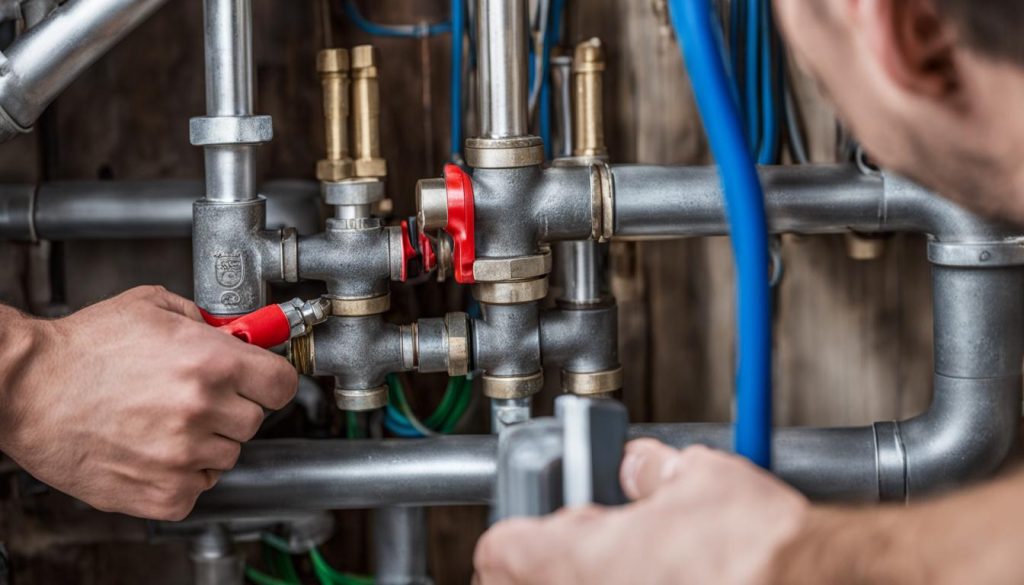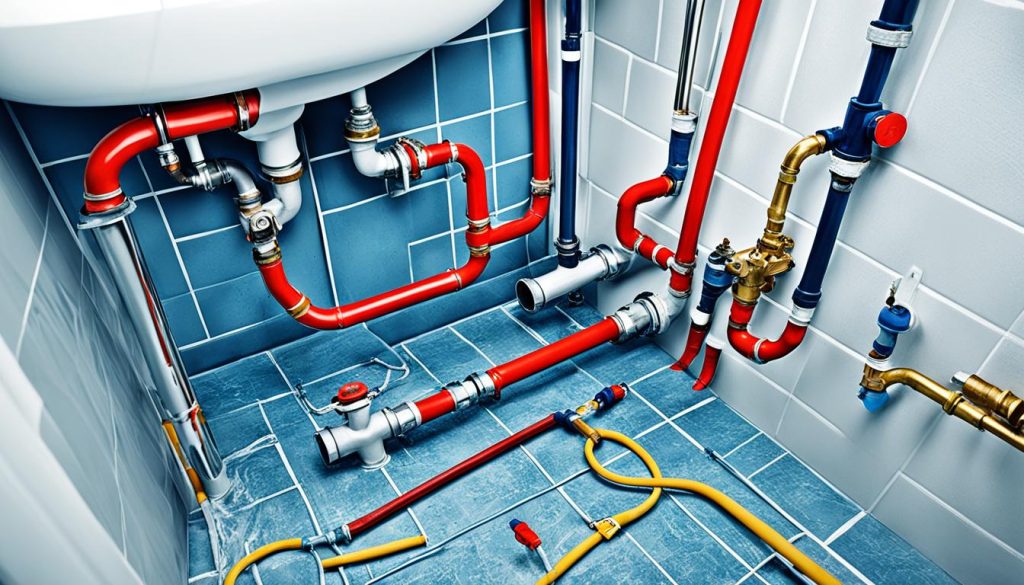Understanding Dead Leg in Plumbing Explained
Did you know that a seemingly innocuous length of pipework in your plumbing system could pose a significant risk to your health and safety? This potential danger lurks in what is known as a dead leg in plumbing.
A dead leg refers to a section of pipe that leads to a fitting but is infrequently or never used. These stagnant water conditions created by a dead leg can increase the risk of bacterial contamination, such as Legionella, in the water system. With its preference for stagnant water, Legionella and other waterborne bacteria find dead legs in plumbing systems to be ideal breeding grounds.
Identifying and managing dead legs in plumbing systems is crucial for maintaining a safe water system. Whether you call them dead ends or blind ends, these sections of pipework closed off at one end can pose a serious health risk if left unchecked.
Key Takeaways:
- A dead leg in plumbing refers to a length of pipework that leads to a fitting but is infrequently or never used.
- Stagnant water in dead legs creates an ideal environment for bacterial contamination, including Legionella.
- Regular maintenance and removal of dead legs are necessary to prevent the spread of bacteria.
- Proper plumbing design, regular flushing of little used water outlets, and adherence to plumbing regulations are essential preventive measures.
- Compliance with plumbing codes ensures the safety and proper functioning of water systems.
What are the Risks of Dead Legs in Plumbing?
Dead legs pose several risks in plumbing systems. The stagnant water in dead legs creates an ideal environment for bacteria, including Legionella, to multiply. This can lead to bacterial contamination of the entire water system, posing a risk to the health of the occupants.
Dead legs can also lead to the formation of biofilms, which provide nourishment and protection for bacteria. Once established, bacteria in dead legs can easily spread to other parts of the system, making it difficult to eradicate.
Regular maintenance and removal of dead legs are necessary to prevent these risks.
Legionella and Waterborne Bacteria
Water stagnation in dead legs creates an environment conducive to the growth of Legionella and other waterborne bacteria. These bacteria thrive in stagnant water and can contaminate the entire plumbing system. Legionella, in particular, is a type of bacteria that causes Legionnaires’ disease, a severe form of pneumonia that can be life-threatening.
By allowing dead legs to persist in plumbing systems, building occupants are at risk of exposure to these harmful bacteria. Legionella and other waterborne bacteria can easily enter the respiratory system through inhalation of contaminated water droplets, leading to serious health consequences.
Preventing the formation of dead legs and ensuring regular maintenance and flushing of water outlets are essential steps in mitigating the risk of bacterial contamination in plumbing systems.
The Impact of Biofilms
Biofilms are slimy layers that form on the interior surfaces of pipes in the presence of stagnant water. These biofilms provide a protective environment for bacteria, allowing them to thrive and multiply.
Once bacteria establish themselves in biofilms within dead legs, they can easily detach and spread throughout the plumbing system. This makes it challenging to eliminate the bacteria and prevent the risk of contamination.
Removing dead legs and ensuring regular cleaning and disinfection of the plumbing system can help disrupt the formation of biofilms and minimize the risks associated with bacterial contamination.
Regular Maintenance and Dead Leg Removal
To mitigate the risks associated with dead legs in plumbing, regular maintenance and removal of these stagnant sections are essential.
- Regularly inspect and identify any dead legs in the plumbing system.
- Ensure plumbing designs minimize the length and frequency of dead legs.
- Implement a flushing schedule for little-used water outlets to prevent stagnation.
- If dead legs are no longer needed, they should be removed entirely to eliminate the risk.
- Follow plumbing regulations and guidelines for dead leg prevention and maintenance.
By taking these proactive measures, building owners and managers can reduce the risks associated with dead legs in plumbing systems and ensure a safe water supply for occupants.
How to Prevent Dead Legs in Plumbing?
Preventing dead legs in plumbing is crucial for maintaining a safe and bacteria-free water system. By following proper design and maintenance practices, you can minimize the risk of dead legs and ensure the health and safety of the occupants. Below are some effective strategies to prevent dead legs in plumbing:
- Minimize dead leg length: During the design phase, it is important to minimize the length of dead legs. Guidelines recommend that the maximum length of a dead leg or pipe should not exceed 1.5 times its width. By keeping dead legs as short as possible, you can reduce the risk of stagnant water and bacterial contamination.
- Regularly use dead legs: Dead legs occur when a length of pipework leads to a fitting that is infrequently or never used. To prevent dead legs, it is crucial to regularly use these outlets and flush the water through them. This removes any stagnant water and helps maintain a healthy water system.
- Flush little used water outlets: Another way to prevent the risk of bacterial contamination in dead legs is by regularly flushing little used water outlets. This ensures that any stagnant water is cleared out, reducing the chances of bacterial growth. Implement a flushing schedule or reminder to ensure this maintenance task is carried out consistently.
- Remove unnecessary dead legs: If dead legs are no longer needed, it is best to remove them entirely. By eliminating unnecessary dead legs, you can eliminate the risk of stagnant water and bacterial contamination in the plumbing system.
- Regular maintenance and compliance: Regular maintenance of the plumbing system is essential for preventing dead legs and ensuring a safe water supply. Adherence to plumbing regulations and codes also plays a crucial role in preventing dead legs and minimizing the risk of bacterial contamination.
By implementing these preventative measures, you can effectively avoid dead legs in plumbing, prevent bacterial contamination, and maintain a safe water system. Remember to prioritize proper design, regular maintenance, and adherence to plumbing regulations to ensure the health and safety of the occupants.
Example: Dead Legs Prevention Checklist
Use the following checklist to prevent dead legs in plumbing:
| Preventative Measures | Details |
|---|---|
| Minimize dead leg length | Follow guidelines to ensure dead legs are no longer than 1.5 times their width. |
| Regularly use dead legs | Establish a schedule to flush water through little used outlets to prevent stagnation. |
| Flush little used water outlets | Regularly flush water through outlets that are infrequently used to prevent bacterial growth. |
| Remove unnecessary dead legs | Identify and remove any dead legs that are no longer needed in the plumbing system. |
| Regular maintenance and compliance | Implement regular maintenance routines and ensure compliance with plumbing regulations. |
Dead Leg Plumbing Regulations
Ensuring the safety and functionality of water systems is of utmost importance, which is why various plumbing regulations and codes have been put in place. These regulations not only cover general plumbing practices but also provide specific guidelines regarding dead legs in plumbing systems. Adhering to these regulations is crucial for preventing bacterial contamination and maintaining the health and safety of occupants.
Dead leg plumbing codes often specify the maximum allowed length for dead legs, as well as the required maintenance and flushing of little used water outlets. Compliance with these codes not only helps mitigate the risk of bacterial growth but also promotes the overall efficiency and longevity of the plumbing system.
By following the dead leg plumbing regulations, building owners and managers can ensure their water systems are in compliance with the highest standards. This not only contributes to the health and well-being of the occupants but also helps avoid potential legal liabilities.
Dead Leg Plumbing Regulations Table
| Regulation | Requirement |
|---|---|
| Plumbing Code X | Maximum length of dead legs should not exceed 1.5 times their width |
| Health and Safety Regulation Y | Regular maintenance and flushing of little used water outlets |
| Building Code Z | Dead legs should be removed if they are no longer needed |
Complying with these regulations is not only a legal requirement but also an essential aspect of maintaining a safe and hygienic water system. Building owners and managers should familiarize themselves with the relevant plumbing codes and regulations to ensure ongoing compliance and minimize the risk associated with dead legs in plumbing systems.
Importance of Dead Leg Awareness in Plumbing
Dead leg awareness in plumbing is essential for maintaining a safe water system and preventing the spread of waterborne bacteria, particularly Legionella. As building owners and managers, we have a responsibility to identify and manage dead legs in our water systems to ensure the health and safety of our occupants.
Regular maintenance, flushing, and removal of dead legs are crucial preventive measures. By conducting thorough legionella risk assessments and working closely with water safety specialists, we can implement effective control measures to minimize the risk of bacterial contamination in our plumbing systems.
In addition to routine maintenance, it is imperative to adhere to plumbing regulations to maintain water safety. These regulations provide guidelines on the maximum length of dead legs and require regular maintenance and flushing of little used water outlets. By following these regulations, we can maintain a high level of water safety and prevent the risks associated with dead legs in plumbing systems.
- Investing Wisely: How Windows & Doors in Boost Property Value and Financial Health - April 24, 2025
- The Financial Impact of Personal Injuries: Why Legal Help Matters for Business Owners - April 16, 2025
- The Hidden Financial Costs of Domestic Assault: What Business Owners Need to Know - April 16, 2025













